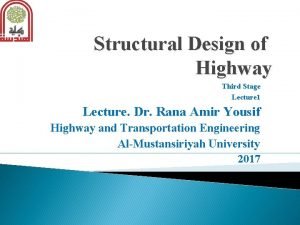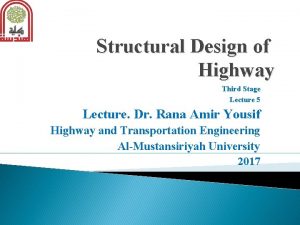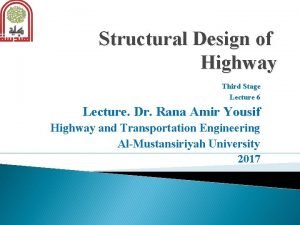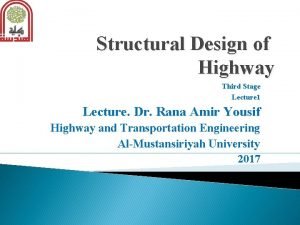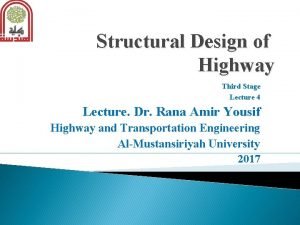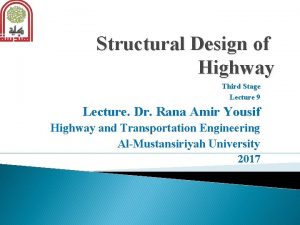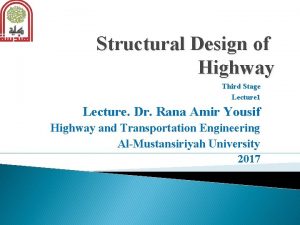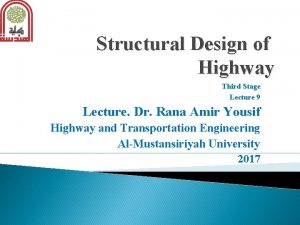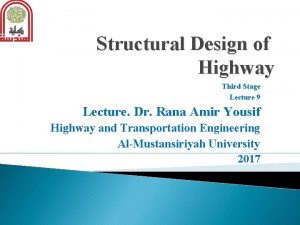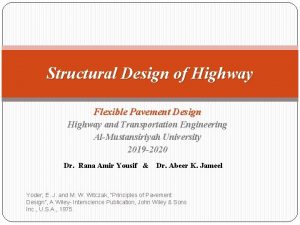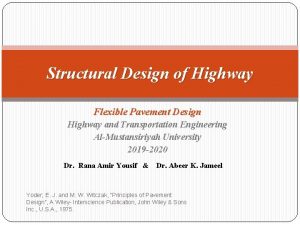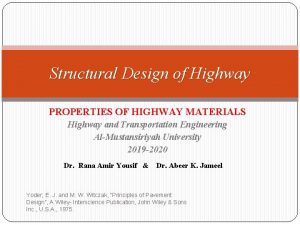Structural Design of Highway Third Stage Lecture 6













- Slides: 13

Structural Design of Highway Third Stage Lecture 6 Lecture. Dr. Rana Amir Yousif Highway and Transportation Engineering Al-Mustansiriyah University 2017

� References: � 1. Nicholas J. Garber and Lester A. Hoel. ”Traffic and Highway Engineering”, Fourth Edition. � 2. Yoder; E. J. and M. W. Witczak, “Principles of Pavement Design”, A Wiley- Interscience Publication, John Wiley & Sons Inc. , U. S. A. , 1975. � 3. Yaug H. Huang, “Pavement Analysis and Design”, Prentic Hall Inc. , U. S. A. , 1993. � 4. “AASHTO Guide for Design of Pavement Structures 1993”, AASHTO, American Association of State Highway and Transportation Officials, U. S. A. , 1993. � 5. Oglesby Clarkson H. , “Highway Engineering”, John Wiley & Sons Inc. , U. S. A. , 1975.






LOAD DISTRIBUTION CONCEPTSOIL � The load (from a vehicle) is transferred to the pavement through loadbearing axles and pressurized tires. The resulting pressure or stress on the pavement, at any depth, is dependent on many factors, such as total load, the number of axles and tires, and the condition of the tires. � The stress on the surface of the pavement gets distributed in an inverted V form from the surface downward. In other words, the stress intensity decreases along the depth of the pavement.

Figure: Concept of Distribution of Stress in the Inverted Form.

SPECIAL TESTS FOR PAVEMENT DESIGN 1 - California Bearing Ratio (CBR) Test This test is commonly known as the CBR test and involves the determination of the load-deformation curve of the soil in the laboratory using the standard CBR testing. The test is conducted on samples of soil compacted to required standards and immersed in water four days, during which time the samples are loaded with a surcharge that simulate the estimated weight of pavement material the soil will support. The objective of the test is to determine the relative strength of a soil with respect to crushed rock, which is considered an excellent coarse base material. This is obtained by conducting a penetration test on the samples still carrying the simulated load and using a standard CBR equipment. The CBR is defined as the penetration resistance of a subgrade soil relative to a standard crushed rock.

The unit load for 0. 1 piston in standard crushed rock is usually taken as 1000 lb/in 2, which gives the CBR as Load a piston (area = 3 in 2) at a constant rate (0. 05 in/min) � Record Load every 0. 1 in penetration � Total penetration not to exceed 0. 5 in. � Draw Load-Penetration Curve.


 01:640:244 lecture notes - lecture 15: plat, idah, farad
01:640:244 lecture notes - lecture 15: plat, idah, farad Forward caries and backward caries
Forward caries and backward caries Caries profunda definition
Caries profunda definition A decorative design or pattern
A decorative design or pattern Structural and decorative design
Structural and decorative design Irc specification for camber
Irc specification for camber Stages of butterfly
Stages of butterfly Stage 2 denial
Stage 2 denial Stage left and right
Stage left and right Diagram of a proscenium stage
Diagram of a proscenium stage Yorhub
Yorhub Stage right stage left
Stage right stage left Stage right and left
Stage right and left Design patterns structural
Design patterns structural














